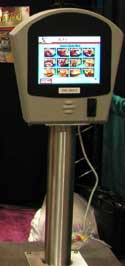Article
Outdoors option requires extra effort
Kiosks deployments aren't just for indoor settings anymore. When it comes to building a kiosk that can withstand temperature extremes, rain and exposure to the elements, there are plenty of issues to consider.
March 26, 2003
Mother Nature can be a formidable foe for outdoor kiosks, but a growing number of manufacturers are figuring out effective ways to fend off the elements. The applications available for these rugged designs include quick-serve restaurants, movie houses and gas pumps.
Pro-Tech, a manufacturer based near Atlanta, is taking advantage of its expertise in the design of kiosks in industrial settings to surge into this new market.
The company's core business is building industrial workstations designed for harsh and hazardous environments, and its clients include several Fortune 500 firms. In 2002, executives saw an opportunity in the design and manufacture of kiosks for outdoor settings, and hired Ted Fithian to head the company's newest business.
Fithian, whose title is manager of business development-kiosk division, said kiosks represent a simple way for Pro-Tech to use its expertise at building sturdy enclosures. He said the market is welcoming Pro-Tech's product, with projects in the works in the loyalty, ticketing and convenience industries.
 |
An outdoor kiosk from Pro-Tech |
"The traditional `outdoor' kiosk has been an indoor kiosk that has been modified to compensate for the additional elements associated with outdoor environments," Fithian said. "This often focused on the enclosure itself and did not necessarily take into consideration the internal components."
He said Pro-Tech's Dura-View kiosk is designed from the inside out, includes proven industrial grade components and a completely sealed aluminum enclosure. The kiosk is built to take on varying ambient conditions.
Taking it to the Sheetz
Radiant Systems (NASDAQ: RADS) wanted to build an outdoor kiosk for a client, convenience store chain Sheetz, which operates 280 convenience stores in five states. The company is testing kiosk units at gas pump islands as part of its MTO (Made to Order) self-ordering system for food.
The order called for especially rugged kiosks to be deployed in Sheetz stores in the Northeast.
Radiant's strategy: No limits
Bob Stone, director of product management of Radiant, said potential applications for the company's outdoor kiosks are food ordering, merchandising, and ticketing, among others. Radiant works with clients to provide software solutions, including POS systems for retailers.
"These hardware products are being offered in response to opportunities to provide customer and employee self-service anywhere, not just in indoor locations," Stone said. "This is an opportune time because businesses are starting to recognize that users actually prefer self-service in many situations."
Stone added that while the retail segment is Radiant Systems' current focus for the outdoor kiosk, the company is by no means limited to that sector. "Although our software applications are focused on retail, we are targeting any self-service market with this hardware platform," he said.
"This includes retail and other industries; there are no limits to specific segments. Radiant offers open technology platforms, with customized form factors, to support third-party application developers and client requirements."
Stone declined to give a price range for the outdoor kiosk line, but said: "Outdoor units will be priced at a premium to our indoor models due to more robust functionality. The actual premium will vary based on unit configuration."
Radiant Systems' outdoor kiosk has been designed to operate reliably from low to hot temperatures. The unit provides a water-resistant design and includes an environmental control system. A 15-inch projective capacitance touch screen provides extreme durability, ruggedized shock resistance and operation with gloves through moisture, dirt and other contaminants.
Radiant's Outdoor Kiosk Features
|
Radiant Systems' kiosks come equipped with a retail-hardened enclosure that provides a sealed unit with heating and cooling mechanics inside, as well as:
Nothing new here
Another company, TouchVision, has been deploying outdoor kiosks for eight years. The Cypress, Calif.-based firm offers several outdoor solutions including freestanding, in-wall, and custom. The product lineup offers flexibility regarding ruggedness, peripheral devices that can be integrated into the system, and climate control.
Company spokesman Greg Roche said TouchVision works with a variety of technologies that improve outdoor systems. Examples include sunlight readable displays, automatic dimming displays, improved near field touch technology, improved climate control packages, remote-computing technology, and ruggedized electronics for temperature and humidity extremes.
"We recently produced a custom outdoor system that integrated two 42-inch plasma displays and two 18-inch interactive stations using remote computer technology that shows you can build just about anything today," Roche said.
Extra effort required
Craig Keefner, publisher of kiosks.org, said the development of reliable outdoor kiosks "requires the full brunt of engineering skills." This engineering must take into account not only environmental factors, but also security and theft issues, he said.
"Everything gets knocked up a couple of notches with outdoor kiosks," Keefner said. "There are a lot of dimensions to them."
What do outdoor kiosks cost compared to mall-based kiosks? Pro-Tech designs, fabricates and assembles its entire unit in house, helping to keep prices down. "Depending on the internal components, our units range from around $4,000 to $10,000," Fithian said.
He said Pro-Tech acknowledges it must take a targeted approach as a newcomer to the kiosk industry. "There are a number of very good manufacturers of kiosks in the country. We're taking the technology and applying it to a different market," he said.
TouchVision's Roche said outdoor designs could add from $500 to $5,000 to the unit price of a kiosk "depending upon the model and climate control features."






